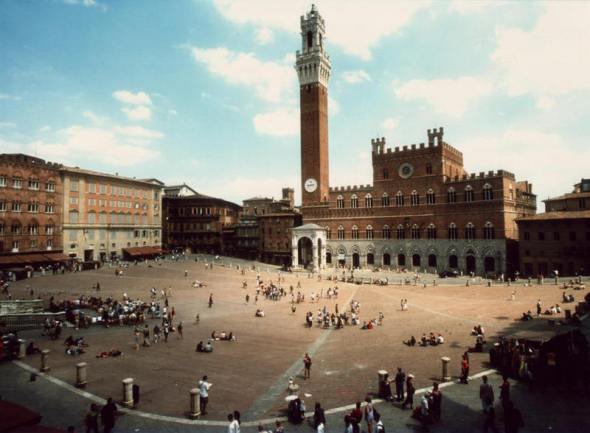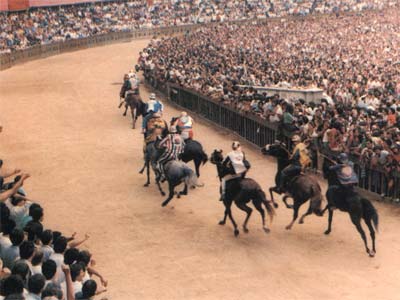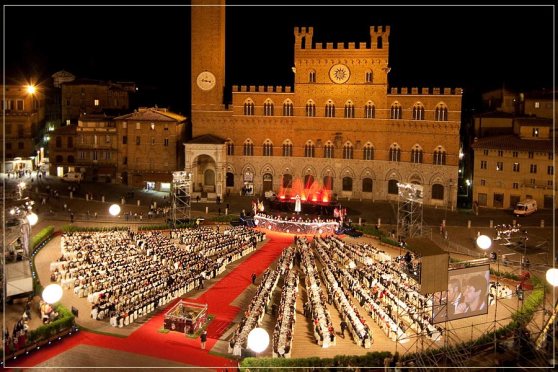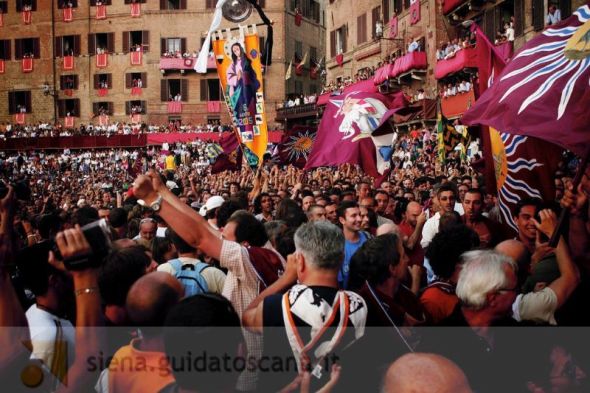Siena is a town in central Tuscanythat counts 59,000 inhabitants and it is the capital of the Siena province. It is one of the most fascinating towns in Tuscany, not only for its sights, but also for its surroundings. Siena lies one hour and a half from Villa Roseto, this means you can actually decide to go and see the world famous Palio (July and August) when here during those times. 
It preserves its medieval character to a remarkable degree, and has been largely unspoilt by new buildings. Piazza del Campo is one of the most famous squares in Italy, where the great Palio horserace takes place. In fact Siena retains a ward-centric culture from medieval times. Each ward (contrada) is represented by an animal or mascot, and has its own boundary and distinct identity. Ward rivalries are most rampant during the annual horse race (Palio) in the Piazza del Campo. 
The streets is Siena are steep as it was built on a ridge, so it is often necessary to cross a deep valley in order to get to the other side of the town. Consequently you need several days to visit every treasure of the town, which has to be done necessarily on foot.
From the hilltop of the town, there is a wonderful varied panorama which includes Monte Amiata and the metalliferous hills, as well as the clay downs of Asciano and the wooded district of Montagnola. To the north, the scenery changes once again, with the densely cultivated hills of the Chianti.
Notable people were born in Siena, as it has always been a lively cultural center: Mauro Pagani, musician, Duccio di Buoninsegna, Saint Catherine, Ranuccio Bianchi Bandinelli, archaeologist and many more.
See a full list of attractions on the Tuscany Pass website
The Palio of Siena
If you would like to savor the experience of living in Italy during medieval and renaissance days then you should be sure to plan to stay in Siena for four or five days during the preparation and race of the Palio. This extraordinary event occurs twice a year from June 29th to July 2nd and from August 13th to August 16th. 
Siena is divided into 17 contradas, which are, in effect, city-states. Each contrada’s boundaries were laid out centuries ago and have remained intact to this day. The central point of the city is the Piazza del Campo, considered neutral territory, where the actual race is run. The contradas radiate out from this marvelous shell shaped piazza and each has its own museum, church, cultural, administrative and social center. The contradas all have their own elected governing body headed by a Priore and another important elected directive head called a Capitano who nominates various assistants to assist in laying out the strategic plan for the actual Palio. The contradas are important to all facets of a member’s life from assistance in times of hardship, to learning the traditions of the city and of the race, to the art of flag and drum display. One is baptized, married and eventually mourned, always in the Church of the contrada. To become a contradiolo from a certain contrada one must be born within its territory; otherwise one can become part of a contrada by choice if one is not fortunate enough to have been born in Siena. The life of the contradas and the race of the Palio have been uninterrupted through the centuries. 
As 17 contenders would be too numerous for the Piazza del Campo, only ten contradas run in each race. In the morning, four days before the race, the preparations for the Palio begin. Horse breeders from various locations around Siena bring their horses to the City Hall on the Piazza. There are trials for each of the horses and the ten captains decide which will be chosen for the race. At this point tension begins mounting as each horse’s number is placed in an urn while the names of the participating contradas are placed another. As each horse’s number is drawn the Piazza becomes completely quiet notwithstanding the thousands of contradioli who have come to see which horse will be allotted to their beloved contrada. As the drawn contrada’s name appears you can see persons rejoicing or weeping according to the quality of their horse.
At this point the Captain must decide which jockey would be most skilled for the horse. As almost all of the contradas have an enemy, part of the strategic plan is to try and do everything possible so that the enemy will not win the Palio or harm their chances for being victorious. The horse is guarded night and day; the jockey is also always accompanied everywhere so that he cannot be harmed or corrupted!. Hundreds of contradioli accompany the horse to the Piazza for each trial, signing praise for their own contrada, for their horse, for their Captain and Priori and jeering at their enemies with century old songs. Each contradioli wears a scarf with the colours of the contrada and throughout the year most would never dream of ever wearing the colours of their enemy even in everything, including their own fists sometimes! Each contrada raises money to be able to pay off the other contradas and other jockeys in case of victory as the Palio is the only race in which the winner must pay.
The evening before the actual race there is a huge banquet following the “Prova General” trial. The larger contradas seat more than 1000 persons and all of the contradas fill the streets or piazzas of their territory with rows and rows of tables, filled with singing contradioli, bottles of wine and plates of food. This is, in essence, the preparation for the Battle!
On the day of the Palio, just after dawn, a mass is held at the chapel on the Piazza del Campo in honor of the jockeys. Slowly during the day one can almost feel the tension in the air becoming stronger hour by hour. Around three in the afternoon each participating contrada gathers in its own church where the horse holds the place of honor. Here the horse is blessed and the priest beseeches him to come back victorious at the end of the race. During the next hours all of the contradas start the historic parade through the streets of the city, dressed in sumptuous handmade costumes. The city of Siena is also represented with hundreds of costumed participants carrying banners and playing century old
instruments. The Piazza del Campo then becomes the main focal point of the city, the gigantic city bell begins tolling and it will continue to do so for almost two hours until the race begins, the parade enters the square at carefully orchestrated intervals, with each contrada represented with its emblems, flag bearers, drums, jockey and horse.
The place that a certain contrada occupies at the beginning of the race is decided by lottery and not disclosed until the horses are actually at the starting point. At this point thousands of voices begin urging their contrada to gain the best starting place available, the horses nervously strain against each other as the jockeys lunge and rear on their horses, offering bribes to their neighbors for a chance to push ahead of all the others. The last horse actually gives the starting signal as it enters the two ropes which form the starting gate.
During the race, which lasts approximately one and a half minutes, all is allowed. The jockeys do not have saddles and thus often fall as they run headlong around the curves of the course; however it is the horse that wins, even if riderless. Each jockey also has a whip, which is more often used against other jockeys, especially one’s enemy contrada. The sound from the spectators is deafening, and the incredible passion of the race all-consuming. The supreme importance is for a contrada to win, coming in second is usually a disgrace as one could have won but did not.
Immediately after the race the actual palio, a silk painted banner, is given to the victors and they then carry it in triumph to the Cathedral or the Church of Provenzano depending on if the race is in July or August so that the Te Deum can be sung in thankfulness for having won. This is only one of the many instances of how the religious and profane aspects of the Palio intertwine. During the evening and through the night the festivities within the victorious contrada never cease and they will continue for almost a year with dinners and celebrations. There are some contradas who win at regular intervals while some have not been victorious for decades. However, the passion of each contradiolo, from small children to older members, never wanes. Everyone’s first love is for the contrada!
THE HISTORY OF THE RACE
“Piazza Del Campo” is still used today for the well known Palio horse race which is one of the most famous popular Italian manifestations. It takes place every year on July 2 and August 16. The Palio is run to celebrate the miraculous apparition of the Virgin Mary near the old houses that belonged to Provenzano Salvani. The holy apparition was therefore called “Madonna di Provenzano” in whose honour the very first Palio was run on August 16, 1656. The Palio was run for the first time in 1701 in honour of the “Madonna dell’Assunta” the patroness and Advocate of Siena through all the tragic events since she protected the Sienese militia at the famous battle of Monteaperti on September 4, 1260, against the Florentines.
The Palio is a historical secular tradition strictly connected with the origin of the Contrada of Siena (districts into which the town is divided). The Contradas are spectacular agonistic institutions each having their own government, oratory, coat of arms, appellations, sometimes titles of nobility, emblems and colours, official representatives, festivities, patron Saints, with protectors, delimited territories and population which consist of all those people who were born or live within the topographic limits of the district, according to the proclamation issued by Violante Beatrice of Bavaria on January 7, 1730, at that time, Governess of the town.
Originally, there were about fifty-nine “Contrada”; now only seventeen remain, ten of which take part in the historical pageant and in the race at each Palio .Here is a list of their names, emblems and colours grouped into “Terzi” or “Terzieri” (in olden times the town was divided into three sections called: “Terziere di Città”, “Terziere di San Martino” and “Terziere di Camollia”).
Terziere di Città
AQUILA (Eagle) a double-headed eagle with imperial symbols. Yellow with black and blue bands.
CHIOCCIOLA (Snail) a snail. Yellow and red with blue bands.
ONDA (Wave) a swimming dolphin wearing a crown. White and blue.
PANTERA (Panther) a rampant panther. Red and blue with white bands.
SELVA (Forest) a rhinoceros bearing a huge tree hung with hunting implements. Green and orange-yellow with white bands.
TARTUCA (Tortoise) a tortoise. Yellow and blue.
Terziere di San Martino
CIVETTA (Owl) an owl. Black and red with white bands.
LEOCORN0 (Unicorn) a unicorn. White and orange-yellow with blue bands.
NICCHIO (Shell) a seashell. Blue with yellow and red bands.
TORRE (Tower) an elephant with a tower on its back. Dark Bordeaux red with white and blue bands.
VALDIMONTONE or simply MONTONE (Ram) a rampant ram. White and yellow with red bands.Terziere di Camollia BRUCO (Caterpillar) a caterpillar. Yellow and green with blue bands.
DRAGO (Dragon) a flying dragon. Red and green with yellow bands.
GIRAFFA (Giraffe) a giraffe. White and red.
ISTRICE (Porcupine) a porcupine. White, red, black and blue bands.
LUPA (She-Wolf) the Roman She-Wolf suckling the twins. Black and white with orange-yellow bands.
OCA (Goose) a crowned goose with the cross of Savoia round its neck. White and green with red bands.
The “Contrada” first appeared in the middle of the 15th century to celebrate certain solemn events. They were represented by special wooden devices shaped like animals, such as, for instance, a giraffe, a dragon, a porcupine, a she-wolf, a caterpillar, a goose etc. – worked from inside by the youngsters of the districts they represented. They were called after the animals themselves.
In ancient times (besides the usual horse-races which took place in many towns of Italy to celebrate certain particular religious and civil events) the Sienese played other kinds of games, such as: Mazzascudo (mace and shield) because the players bore maces and shields; the Giorgiani in honour of San Giorgio (battles with blunt weapons); Elmora detto dei cestarelli because the players wore certain funny baskets (cestarelli) on their heads; le Pugna (punching) abolished in 1324 because the players started throwing stones at one another, then weapons and sticks were used and a real battle ensued. To re-establish order the Bishop was compelled to descend into the square with a train of priests and monks. “La pallonata”, a game played between the “Terzi” of the town. A huge ball was thrown from the top of the “Mangia” tower by the youngsters of one of the “Terzi” into the field of their opponents. This game was played on January 13, 1555 for Biagio di Montluc, the French Marshall.
Of all these games only the Palio has survived. The preparations for this parade are slow and methodic like a liturgical procedure. Four days before the day of the Palio trials take place in the “Campo” square which is turned into a race track. A thick layer of earth is spread on the ground and a row of mattresses is placed against the walls at the dangerous corner of San Martino to protect the jockeys in case they fall.
The whole square is amazingly fit for such manifestations because its shape is that of a mediaeval Roman amphitheatre closed at the base by the straight line of the Palazzo Pubblico. Besides being semi-circular this peculiar square is also funnel-shaped like the theatres of the imperial age. Eleven streets run into it, though it is extremely difficult to perceive them from the middle of the square. All around the track, perched up against the walls of the houses, seats are arranged one behind and above the other like bleachers. Windows, balconies and loggias, too, are made ready for the visitors; 33,000 seats in all, but they are far from sufficient and are always sold out long before the day of the performance. In the centre of the square there is room for about 28,000 people to stand, but this is not enough either and the roofs, the turrets and the cornices of the old houses looking on to the square are also crowded. There are people everywhere, even in the most unlikely places.
On both the appointed days every year the “Contrada” – that is to say all the Sienese population – compete for a prize which is but a hand painted silk banner (pallium). Each “Contrada” is represented by a group of young men called “Comparsa” arranged as follows: one drummer, two flag-bearers, with their flags, one “Duce”, two grooms, one page carrying a flag with two pages at his sides carrying the emblems of the “Contrada”, the race-horse called barbero with a jockey called “barbaresco”, last the jockey who is to run the race on a parade horse called “soprallasso” followed by a groom.
The historical parade is a lively display of rich medieval costumes which date back to the time period from 1430 to 1480; their colours are as bright as one may fancy. The procession goes winding its way round the “Campo” square in the following order: the flag-bearer of the Commune on horseback bearing the standard of Siena (the black and white Balzana) followed by his groom, a group of drummers, a group of trumpeters and musicians called “musici di Palazzo” playing the march composed for the Palio by Pietro Formichi in 1875 on their bugles, the Captains, the representatives of the “Podestà” (called podesterie), the flag-bearers with the standards of the “Terzieri” of the town and of the lands belonging to the Commune called “Masse”, the flag-bearers of the Corporations of the Arts and Crafts, the captain of the people (Capitano del popolo) on horseback and a group of flag-bearers with the flags of the old Sienese Republic.
Next comes the representatives of the “Contrada” called “comparse”. The first ten are those which are to run in the Palio horse race; they are followed by a row of young pages bearing festoons of laurel leaves and then by the seven “Contrada” that do not run (they have no “barbero” and no jockey).
Next comes the captain of Justice (Capitano di Giustizia) riding a horse and then the representatives of the seven “Contrada” that no longer exist: Cock, Lion, Beam, Oak, Sword, Viper. Last comes the triumphal chariot (carroccio) drawn by huge oxen. In the chariot are seated the four “Provveditori di Biccherna” (administrative authority who in times of yore used to superintend public representations, along with the oriflamme of the Commune, the Palio to be awarded to the victor, and a group of trumpeters.
When this magnificent pageant has slowly gone round the square, all the representatives go to sit on a platform raised just for the purpose beneath the windows of the “Palazzo Pubblico”. When they have all been seated there, they look like a strange army after some brilliant victory or a train of heroes or of poets ready to enter Paradise. As soon as everything is quiet, the flag-bearers from all of the “Contrada” perform together with their flags in what is most commonly known as “gioco delle bandiere”. They throw them high up into the air and catch them again before they touch the ground; it is a splendid, most decorative display of colours accompanied by the beating of drums, the sound of bugles and trumpets and the chimes of the big bell on top of the “Mangia” tower; the little bell on the chariot, known in Siena as “Martinella”, is also very busy ringing.
All of this is but a prelude, a time of anxiety and expectation. When at last the horses appear and the race starts, the crowd becomes delirious. The jockeys goad their horses round the square three times and the people shout as if the town were about to fall.
The spirit of Siena is in the very colours of her “Contrada” and in all the manifestations connected with each of them. First of all, the benediction of the horses and jockeys, each in the church of their own “Contrada”, early in the afternoon just before the Palio. It is this spirit that animates the whole manifestation and contributes such enthusiasm and pathos to the scene.
This traditional popular manifestation lasts four days (from June 29 to July 2 and from August 13 to 16) and finishes in the streets of the victorious “Contrada” where the people celebrate the happy event in a most joyous way. Winner takes all! Whoever happens to be in Siena during these exciting days is swept along with the enthusiasm of the people for the Palio and, of course, the final victory.